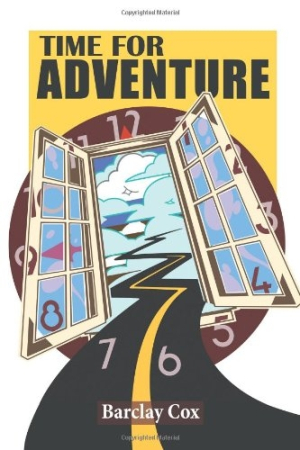Time for Adventure
On his way home from school one day, ten-year-old Zy stumbles upon a strange building that transports him into the future. Zy adapts quickly to his technologically advanced surroundings and settles in with a new family, but he soon realizes that he misses his real family and his life at home.
Although the beginning is a bit convoluted and slow, Time for Adventure picks up rather quickly. Barclay Cox paints an intriguing picture of the future, with spray-on clothing that peels off and a family home designed to limit private space and increase interpersonal connection. It is soon clear that Zy has entered a unique society, where violence is no longer acceptable, thanks to superchips implanted in people’s brains that monitor negative emotion.
Cox’s writing is pragmatic and entertaining; unfortunately, it can also be overly expository. The story is told in a straightforward way, often without using dialogue or action to push the plot forward, which makes the writing less enthralling. In some cases, Cox uses creative ways to unfold scenes, such as an overheard conversation, flash back, and flash-forward; when these devices are applied, the writing improves significantly. There are a few other minor problems, including clunky transitions from paragraph to paragraph and occasional mismatching tenses, but overall the writing is clean and functional.
Zy is quirky and charming, but his ten-year-old voice feels slightly inauthentic. At times, the narrator portrays Zy in a manner that seems to go beyond the understanding of someone his age. When describing the superchip that monitors people’s actions, for instance, the narrator states that, “Zy felt like this was ‘big brother’ government to the extreme; although by this time in his future, the planet’s population had decided, by weighing up the pros and cons, it was in people’s best interests to accept this inconvenience for its inherent benefits.”
The themes in Time for Adventure are often imaginative and captivating, but a few of the plotlines could have been fleshed out more fully, including one about how time travelers can only affect the future if they choose to put the traveling device into “interact mode.” Cox’s story begs to be part of a series of books—perhaps a collection of Zy’s many time-traveling experiences, or the time-shifting adventures of other children.
Even with its imperfections, Time for Adventure is the sort of book that is perfect to read under the covers with a flashlight, where it will encourage young readers to dream about the possibility of traveling in their minds.
Reviewed by
Colby Cedar Smith
Disclosure: This article is not an endorsement, but a review. The publisher of this book provided free copies of the book and paid a small fee to have their book reviewed by a professional reviewer. Foreword Reviews and Clarion Reviews make no guarantee that the publisher will receive a positive review. Foreword Magazine, Inc. is disclosing this in accordance with the Federal Trade Commission’s 16 CFR, Part 255.

